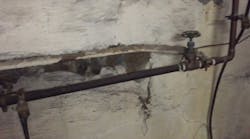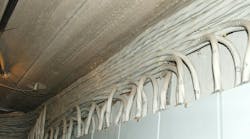A facility manager — who wishes to remain anonymous — recently sent us this photo. Unfortunately, he found this at his own facility! This situation was uncovered when he and another worker were removing 8 in. of snow from the roof. The box is located on top of what appears to be a mushroom fan. Water was trickling down through the metal-clad armor and finding its way to a junction box inside of the building. In addition, the blue insulated conductor was energized at 120V. Needless to say, he was not happy.
When this equipment was originally installed, the Code would have required this box to be suitable for use in wet locations, as required by 314.15. Additionally, 314.25 would require this box to have a cover. Another concern is that type AC cable is prohibited from being used is wet or damp locations, as noted in 320.12, and the opening at the top of the box should be closed with a KO seal, as called for by 110.12(A).
Abandonment of equipment is common in most all commercial and industrial occupancies at one time or another. During the course of preparing this piece, I was unable to locate any code or standard that would provide guidance for properly performing such an operation. However, in the absence of a published guideline, common sense must prevail.
Whenever you “safe-off” or abandon a piece of equipment or a circuit, your first step should be to make sure you de-energize the circuit. Next, remove all equipment, such as the box and the cable supplying the box. At least cover the box and physically disconnect the circuit conductors from the overcurrent protective device to help ensure the circuit is not unintentionally re-energized at a later date.





